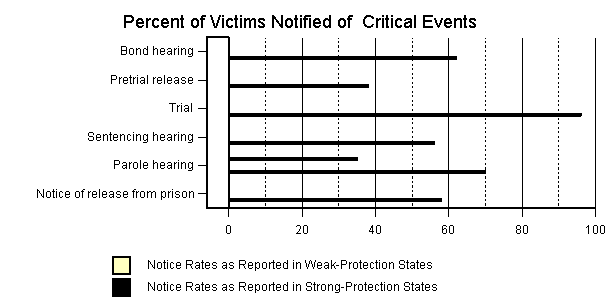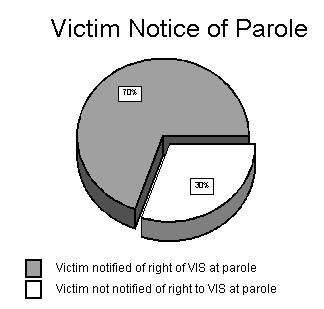

Implementing Victims' Rights: Why Corrections Professionals Should Care
Corrections professionals have always carried a seemingly overwhelming burden of responsibilities from provision of housing and supervision of incarcerated offenders at various levels of security to provision of multiple programs and treatment for offenders to supervision of offenders in the community. Given such a burden, why should corrections professions shoulder yet another duty such as the implementation of victims’ rights?
One reason might be because it’s the “right thing to do.” A second reason is illustrated by the fact that a growing number of corrections professionals have concluded that addressing victim issues and interests in the context of the corrections system benefits not only the victim, but also benefits the process. For example, parole hearings, where the victim is notified and present to provide an impact statement, actually provide parole boards a fuller understanding of the facts surrounding the crime — beyond offering a sense of the true magnitude and impact of the crime.
There is a third reason that corrections professionals should “care” about and enforce victims’ rights — it’s the law.
Corrections-related Victims’ Rights
Over the last 20 years, more than 30,000 victim-related laws have been passed at the state and national level. Thirty-two states have even gone so far as to pass amendments making victims’ rights part of their constitutions. While not all rights relate to the corrections process or are the responsibility of corrections professionals, there are many victims’ rights that are solely their responsibility.
Right to Notice
The victim’s right to notice is considered by many to be the most important because it is the “threshold” that allows victims to access the other rights. Victims cannot, as a practical matter, exercise the right to attend a hearing and provide an impact statement if they are never informed of the place, date and time of the hearing. Thus, notification is the one affirmative victim right that requires a proactive approach on behalf of the notifying agency.
Moreover, studies have shown that victims rate “being informed [of various developments regarding the case]” as more important than any actual outcome of the case, such as the length of the sentence.
Historically, such information was provided on an informal basis, but with the advent of recent victim legislation, providing victims with the right to be informed of critical correctional proceedings is most likely mandated by state law and protected as a matter of right. Though state laws differ, most assign corrections professionals the duty to notify victims of hearings related to the offender, such as parole hearings. Many state statutes have also mandated that correctional agencies provide victims with “offender status” information including escape, recapture, permanent transfers between facilities, temporary release (e.g., furlough), parole and permanent release. A few states even require correctional agencies to inform victims with a best estimate of the earliest date that the incarcerated offender would be eligible for release.
Notice Implementation Strategies
Corrections have adopted various strategies to carry out their duty to provide victims with notice, both of events and inmate status. The most common approach typically entails notice by mailed letters — often registered mail. Others rely primarily on telephone calls made directly to victims by staff. In recent years, some have employed a high tech approach by implementing automated notification systems, which utilize computers to make telephone calls informing victims of the time and place of hearing. But even in the case of automated systems, corrections personnel charged with the duty to provide notification must still possess the skills, the bills, and most importantly, the will to effectively implement these strategies.
Implementation Issues — Skills, Bills and Wills
Both empirical and anecdotal examination of the victims’ rights implementation process highlight with clarity the important role skills play in implementation — skills, both in terms of knowledge and ability. If a corrections professional is unaware of their duty to carry out the implementation of a victim’s right, it is a virtual certainty that victim will be effectively denied that right. By the same token, if a corrections professional lacks the ability to create and maintain a case status tracking system cross-referenced to relevant victims, it is not likely that the notice, no matter what form it takes, will ever find it’s way to the victim.
Even the most efficient schemes still involve considerable resources — most often taking the form of human resources. While automated systems can save substantial amounts of staff time by helping to track case status, cross reference the case with victim contact information, and even generate the notice via letter or voice, the cost of these systems pale in comparison with the labor cost involved with the “human aspect” necessary to operate the system. Cost is often cited as the reason correctional agencies are unable to fulfill their notice responsibilities. Yet, the relative cost of each notification is dwarfed when compared with the amount spent to incarcerate and rehabilitate offenders — to say nothing of the human cost that may result as a consequence of failing to implement a basic victim right (i.e., a stalking offender who murders a victim who was never notified of his release). Even so, those who allocate resources within the correctional agency will have to come up with a few more resources to pay the bills involved, no matter how modest.
Finally, for victims to consistently be granted their statutory and constitutional rights in the context of the corrections system, professionals responsible for the operation of that system must have the will to carry them out. Obviously, it takes will to secure both the skills and the bills necessary for implementation of victims’ rights. But beyond the skill and the bills, it takes a commitment to create and maintain the systems that deliver on the promise made to crime victims by the elected officials (in the case of statutes) or the people (in the case of constitutional amendments) when they made such mandates the law of the land.
To the uninitiated, the passage of such legal mandates would seem to settle and solve the issue of victims’ rights in the criminal and juvenile justice system. Those who work within the system, and most certainly victims themselves, know the facts to be otherwise.
Implementation Rates of Victims’ Rights in the Criminal and Juvenile Justice System
Chart 1

Study after study have consistently shown that rights of crime victims within the criminal and juvenile justice system are not consistently observed within the system despite clear statutory and constitutional mandates by states. In fact, the most comprehensive multi-state study conducted in recent years — Statutory and Constitutional Protection of Victims’ Rights: Implementation and Impact on Crime Victims, funded by the National Institute of Justice, U.S. Department of Justice — indicated that basic victims’ rights are observed less than 50 percent of the time.Even in states with the strongest statutory and constitutional protections, substantial numbers of victims reported that they had not been notified of critical events in the process. (See Chart 1.)
Chart 2

Victims in states with weaker mandates reported much lower notification rates. For example, notice of parole hearings in weak-protection states were a full 50 percent lower. Even while correctional agencies in the states surveyed seemed to be doing a better job of providing notice of parole hearings than their counterparts with respect to other hearings, still nearly 1 in 3 victims was not notified. (See Chart 1.)About the same percentage were notified of Chart 3their right to provide an impact statement at parole hearings. (See Chart 2.) Interestingly, of those who were provided with such notice, the vast majority actually exercised their right to provide an impact statement. (See Chart 3.) The implication is clear — when given the opportunity, most victims choose to exercise their rights regarding parole.
Overcoming Implementation Barriers
The study asked criminal justice professionals, including corrections officials, the reason victims did not receive the notice that was their duty to provide. The answers were similar to those already mentioned — they lacked the skill, the bills, and/or the will.
How might these barriers to implementation best be addressed? As far as skill is concerned, the answer is education and technical assistance. Educating corrections professionals regarding their notice responsibilities as required by law might be as simple as an annual training or as comprehensive as an implementation manual. However, creating the process that assures notice to victims is more likely an issue of developing the policy and establishing the infrastructure which may require technical assistance from victim services and corrections professionals who have already developed such processes for other jurisdictions.
Finding the resources necessary to establish and maintain a notification system is never an easy task — no matter how modest these expenses may be. Nevertheless, a growing number of jurisdictions are using creative means to both reduce overhead costs (e.g., automated notification) and secure the additional funding necessary. Some simply found the money by shifting priorities within their own budget; others looked for support from victim-specific funding sources. More than a few correctional agencies have created victim service provider positions within the agency itself. Having such a full-time staff position(s) that focuses exclusively on meeting the legal mandates of the law concerning crime victims, in addition to addressing their broader needs, is proving to be one of the most effective means to accomplish both, while at the same time building collaborative partnerships with victim service programs throughout their jurisdiction. Yet again, each of these solutions depend on the willingness of corrections professionals to implement them.
But what if the professional charged with the duty has the skill and the bills, but simply lacks the will? For whatever reason, they simply refuse to carry out their responsibility toward victims and their rights. What can the victim or anyone else do about it?
The effort to address this question is ushering in what many regard as the second wave of the victims’ rights revolution. After 20 years, victim policy leaders at the state level are shifting their focus away from passing statutes toward finding the means to enforce victims’ rights statutes.
Enforceable Victims’ Rights
Policy leaders in some states have actually found the solution in more statutes. Colorado, for example, passed an enforcement statute that allows victims, who feel they have been denied their rights, the option of filing a complaint with a statewide Victim Board. If the Board cannot mediate a mutually-acceptable solution, they can refer the case to the Colorado Attorney General, who can then choose to file a suit against the non-complying official — an option he has yet to find the need to exercise. Wisconsin has taken the concept even further, allowing its Review Board to bring enforcement proceedings that can include fines for unrepentant non-compliance.
Arizona has taken a different approach. The State Victim Assistance Agency regularly conducts victims’ rights compliance audits of agencies charged with implementation. Though virtually all result in mutually agreed upon strategies to assure compliance, the State Victim Assistance Agency retains the power to curtail or withdraw funding from agencies that refuse to comply.
Note that each of these enforcement schemes relies on the actions of some third party to compel compliance. Yet, this is not the only recourse available to victims. Victims, victim advocates and their legal advisors are beginning to undertake enforcement measures that rely solely on the victim’s legal standing to petition the courts for a remedy when their rights have been trampled. Some statutes specifically provide for such standing, but most rights — particularly constitutionally-granted rights — carry with them the implied standing necessary to enforce them. Such “self-enforcing” rights are serving as the basis of a growing number of legal actions brought by, or on the behalf of, crime victims. While some of these suits have resulted in adverse rulings for victims, and ever-increasing number of courts are upholding victim rights’ and remedies. In a few cases, courts have actually invalidated hearings where authorities failed to observe the rights of the victims affected.
State ex rel Hance v. Board of Pardons and Paroles – A Precedent or Prognostication?
The most renown case of such court action occurred in Arizona. A young woman was brutally attacked and left for dead in the Arizona desert. She survived, and her attacker was sentenced to a lengthy term of imprisonment. After serving several years, he was granted parole. The Parole Board made no attempt to notify the victim who was on record. However, before the offender was released, the victim and the prosecutor learned of his impending release and filed with the court to overturn the Parole Board’s decision. Citing the Board’s failure to provide the victim with notice of the parole hearing and her right to attend and provide an impact statement, the Arizona Supreme Court, ordered a new parole hearing. At the second hearing, the victim was present and provided an impact statement. The Parole Board then reversed itself, denying the offender’s release.
ConclusionDespite the legal mandates, victims’ are routinely denied their rights in every phase of the criminal and juvenile justice process. While corrections professionals have always had the option to observe victims’ rights because they viewed victims as clients of corrections and victim safety as public safety, trends in statutory and case law are making compliance with the law less of an “option,” and more of the mandate that lawmakers had intended. Though some may view this as yet another unfunded, unrealistic burden, it should be noted that state justice agencies, including many correctional agencies, around the country have managed to find a way to develop the skills and pay the bills. But they cannot do either without first finding the will!
Why should corrections professionals care about victims’ rights? Because it’s not only the victim’s right, it is corrections’ duty. In fact, it is their sworn duty.
Endnotes . David Beatty, Dr. Dean Kilpatrick, and Susan Smith Howley. (December 1998). The Rights of Crime Victims – Does Legal Protection Make a Difference? NIJ — Research in Brief. Washington, D.C.: National Institute of Justice, U.S. Department of Justice. (Copies of this NIJ Research in Brief and the full report, Statutory and Constitutional Protection of Victims’ Rights: Implementation and Impact on Crime Victims are available from the National Criminal Justice Reference Service. (NCJRS). Through NIJ’s Data Resources Program, the data generated by the study have been deposited with the National Archive of Criminal Justice Data (NACJD) and are publicly available. The data can be accessed at the website of the Inter-university Consortium for Political and Social Research (ICPSR), which administers the NACJD: http://www/icpsr/umich.edu/NACJD/archive.html or by contacting ICPSR, University of Michigan, Institute for Social Research, P.O. Box 1248, Ann Arbor, MI 48106-1248 (phone: 734-998-9900).
. Ibid., p. 9.
. Ibid., p. 9.
. Ibid., note 1.
. Ibid.
. State ex rel Hance v. Board of Pardons and Paroles, 875 P. 2d 824 (AZ CT APP 1993).
![]()
To Search The Justice Solutions Web Site:
![]()
For comments or concerns regarding this web site, please contact:
![]()
Copyright © 2011.
Justice Solutions.
All Rights Reserved.
Last Modified:
April 2, 2011
![]()

